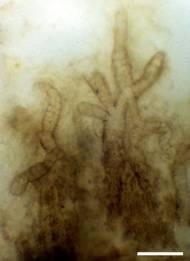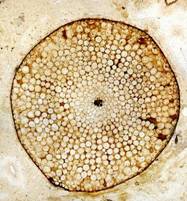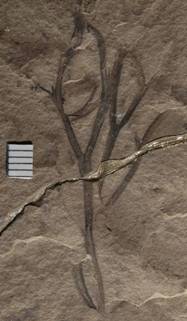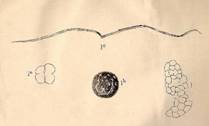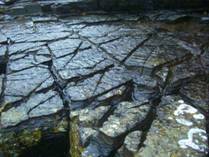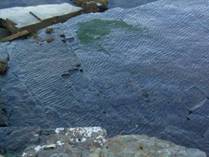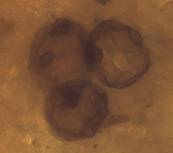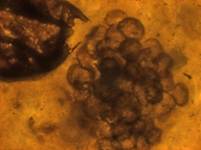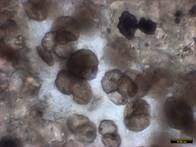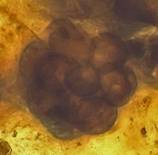
Harrow and Hillingdon Geological Society
Not Just Sticks and Balls
Home | Monthly Meetings | Field Trips | Exhibitions | Other Activities | Members Pages | Useful Links
Not just sticks and balls: a new perspective on the origin of life on land
Leila Battison
Leila Battison spent 4 years as an undergraduate in geology at the University of Oxford and is now in the 4 th year of her PhD in palaeontology, which is due to be completed by 1 May. She was interviewed on Radio 4 on 14 April last.
The talk covered:
- What we thought we knew;
- What Leila found; and
- What we know now.
What we thought we knew
Thinking about life on land, humans live everywhere they can but even where humans cannot live, living things are all over the planet. Over 50% of vertebrates live on land. There are lots of fossils of marine fauna and flora but it is a lot more difficult for terrestrial organisms since land is a much more destructive environment for fossilisation.
Much of the record of life on land is in coal swamps, such as the Coal Measures at 32 million years. The Rhynie chert is a silica deposit from hydrothermal vents which preserves vascular plants from about 405 million years. At 425 million years, Cuxonia are the very first fossils of macroscopic plants on land. Proxy data from sulphur isotopes in pyrite and other sulphides and sul0phats is used to show that at 1 bullion years there was too much oxygen around if there had been no life on land and is thus used to indicate a land biota. Torridonian palaeosols are ancient soils right back in the Proterozoic, but this is not definitive since palaeosols can also be formed by intense chemical weathering rather than biological activity.
|
|
|
Rhynie Chert |
Rhynie Chert |
Cuxonia |
The Precambrian fossil record is poor prior to the explosion of life at the beginning of the Cambrian, eg the Burgess Shale and the Ediacaran biota at 580-540 million years, which are probably animals. The fossil preservation is weird since there are no hard parts. Microfossils include possible fungi at 700 million years and at 1,000 million years the earliest example of eukaryotic fossils preserved in chert. The microfossils in the Torridonian are not impressive in that what we are seeing is “just sticks and balls”.
What Leila found
The Torridonan is a pile of red tabular sandstones about 5km in thickness. Within it the Diabaig Formation at 1 billion years has shales and sandstones at the top and bottom of the unit. There was a huge landscape unconformity on the Lewisian and the shales formed in the bottom of Lewisian lakes. Peach and Horne of the Geological Survey of Great Britain mapped the area and in 1907 published The geology of Scotland, which contained a page of drawings by Teall of Cambrian trilobites and Precambrian microfossils found in nodules of phosphate. Subsequently Zhang, 1982 published on ball-structured microfossils.
|
|
|
“Sticks & balls” from Teall, 1907 |
Desiccation cracks & ripple marks |
Multi-directional ripple marks |
Leila wanted to prove that the shales were deposited in lakes and find more exciting fossils than “sticks and balls”. Evidence includes the frequency of desiccation, with huge networks of desiccation cracks, together with ripple marks that are symmetrical and about 3cm in wavelength and multi-directional. These are really quite small and reflect a very small fetch for wind. Changing direction of ripple marks rapidly is not common in the sea and provides good evidence of a more changeable terrestrial environment. There are classic cyclothems in the Cailleach Head Formation, coarsening upwards reflecting the infilling of a basin, with repetition due to water level fluctuation. Phosphate forms laminations on the shale.
|
|
|
|
|
|
Precambrian microfossils in phosphate and speculative life-style |
||
Using biological thick sections of the phosphate 100μm thick, Leila found 3-dimensional ball microfossils with a cell wall 500nm thick and showing evidence of dividing cells. The speculative life-style starts with a single cell, which will encyst, the cells dividing within the resistant shell and then germination with tiny fossils emerging from the cyst. Sometimes clusters of cells are encysted.
Laser ion spectroscopy was used to differentiate between organic carbon ((types C and D) and random carbon (type G). Transmission electron microscopy gives ultra-high resolution photography of a 50nM thick section and shows the thickness and layering of the cell wall suggestive of eukaryotic algae.
The result of this work was a letter to Nature co-authored with Paul Strother, Martin Basker and Charles Wellman on “Earth’s earliest non-marine eukaryotes. Evidence is provided by a combination of:
- Large size, generally in excess of 60μm;
- ornamentation around the edges of cells, spines etc;
- Multiple layers arising from the complicated chemistry within the cell.
Most of the fossils of co-workers were from acid digestion of shales but the best preservation is in phosphate, which enables the relationships between the “sticks and balls” to be seen..
What we know now
Terrestrial lakes in Precambrian Torridonian rocks in Scotland contain eukaryotic algae(?) in different environments within the lake system:
- Sheildaig Formation is a mid-delta top area with lots of sands and clusters of cells reflecting an open-water environment;
- Diabaig Formation has desiccation cracks and ripple marks in shales and contains vastly different community to everywhere else, reflecting a planktonic flora with encystment to resist desiccation and filaments;
- Fladday Formation has fossils up to 0.5mm across with cells inside and striations, mostly in shales but with no sedimentary structures, representing benthic eukaryotes.
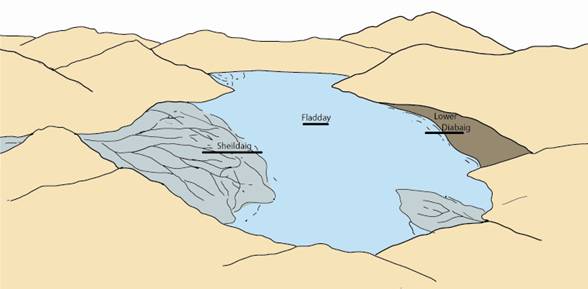
Schematic diagram of Torridonian lake environments
The future direction of this work is seen as being further study of the decay processes preserved in phosphate and the classification of environments, study of possible trace fossils and possible microbial mats.
